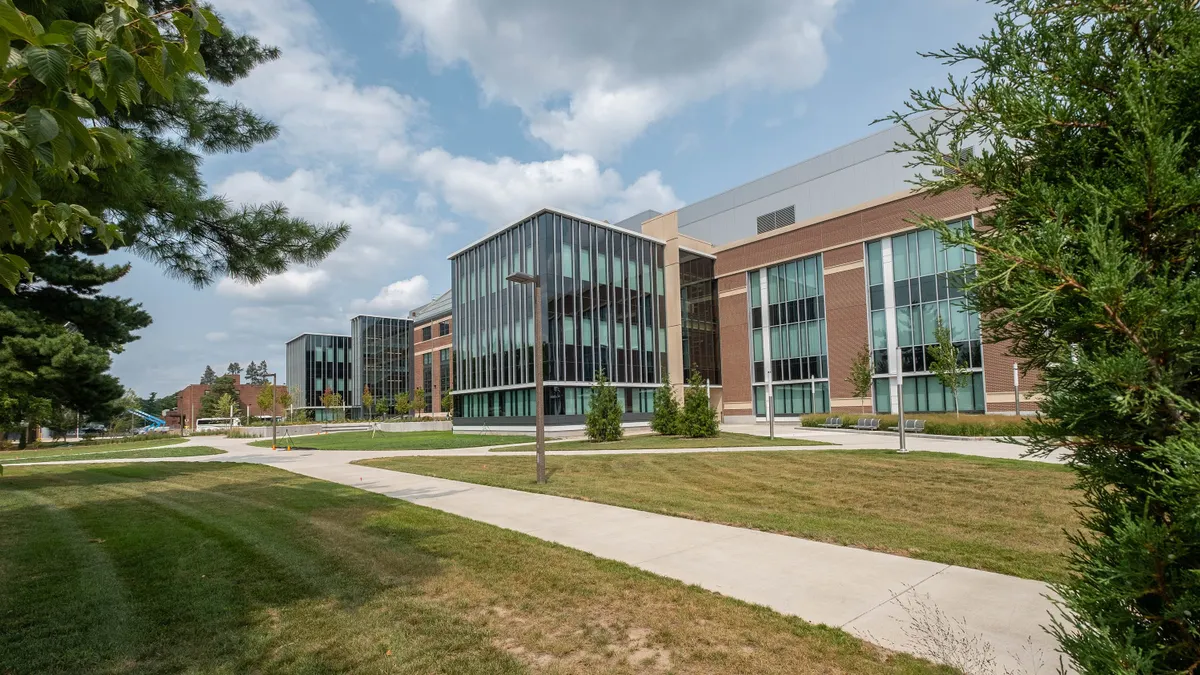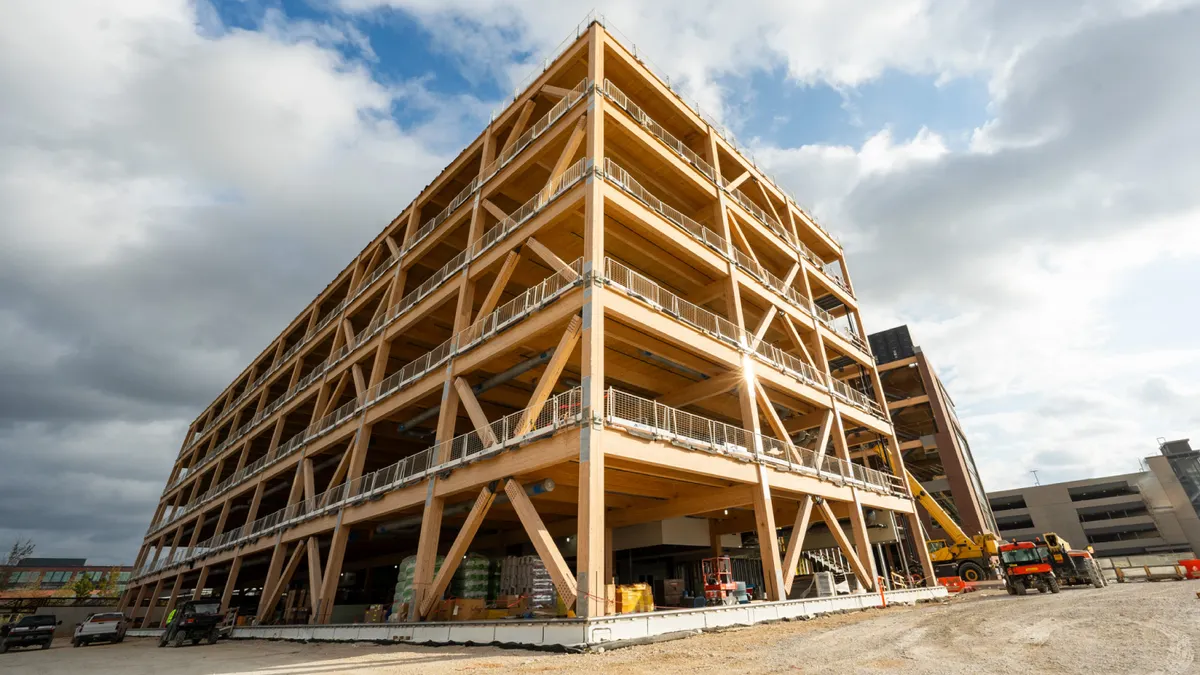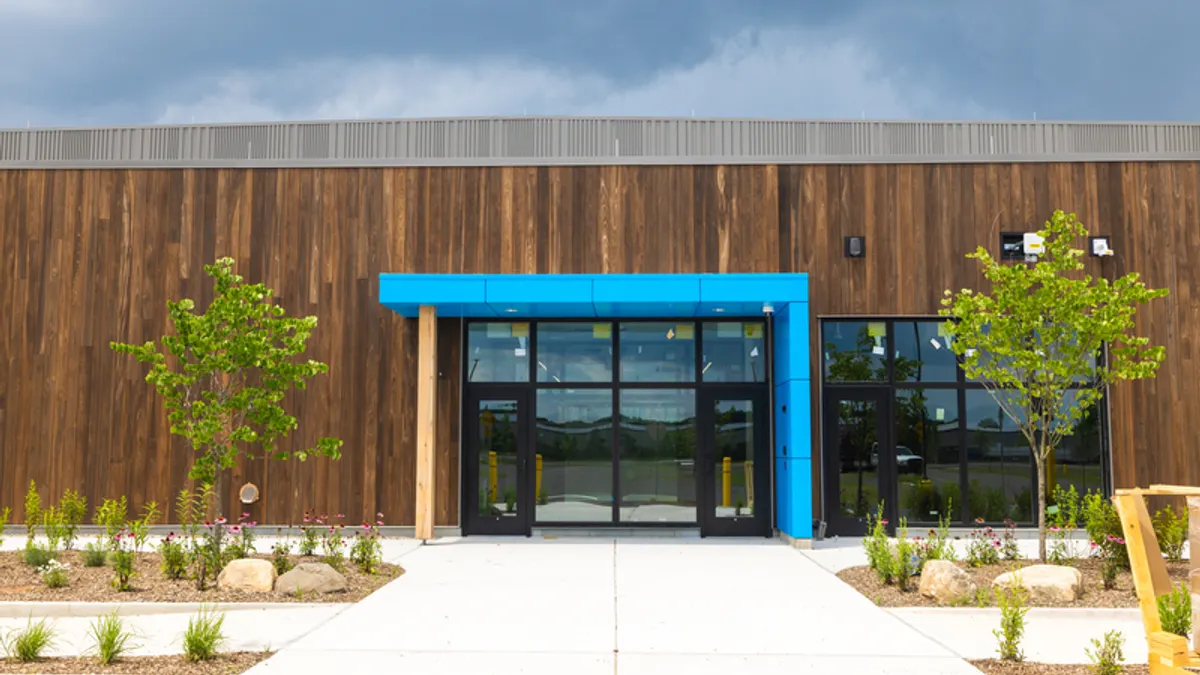John Klein, Massachusetts Institute of Technology research scientist and head of architecture and building firm John Klein Design, has a particular interest in mass timber. After working in London and Beijing, Klein came back to the U.S. to “find new ways and approaches to address the challenges of the built environment.”
The urban built environment accounts for 75% of global greenhouse gas emissions each year, with buildings alone representing 39% of that figure — a staggering sum from any perspective.
Green building certifications abound as eco-conscious building owners strive to lessen their structures’ impact on the environment, reduce tenants’ energy bills and provide more comfortable spaces. Other groups are issuing challenges to meet even more stringent sustainability goals, such as Architecture 2030's zero-carbon-emissions objective.
Wood is inherently sustainable. The natural, renewable resource takes very little energy to manufacture, especially when compared to other traditional building materials such as concrete and steel, and it naturally sequesters greenhouse gases. With mass timber becoming more prevalent in the U.S. because of its sustainability and other benefits, architects, engineers and contractors now have a way to use wood in much larger buildings than typical stick-built structures allow.
As he started examining engineered timber products more closely, Klein had a moment where it all “clicked.” He referenced McKinsey and Consulting’s report about construction’s inefficiencies, which also outlines opportunities for increased productivity, including adopting more sophisticated processes, prefabrication and building with repetitive parts.
“From that standpoint, mass timber is perfect because it’s machined by CNC [computer numerical control] equipment,” he said, pointing out that digitalization of the methods used to work with mass timber is one of its many selling points for designers and contractors.
But first, what exactly is mass timber?
Mass timber is defined as “a category of framing styles characterized by the use of large solid wood panels for wall, floor and roof construction,” according to the American Wood Council. It also includes sculptural and non-building structures formed from solid wood panels or framing systems of six feet or more in width or depth. Although cross-laminated timber, or CLT, is the most publicized form of mass timber, it's also used in dowel-laminated timber, nail-laminated timber and other forms.
In August, Oregon became the first state to codify mass timber use in buildings taller than six stories. The International Code Council earlier this month voted to preliminarily approve mass timber in new buildings up to 18 stories in the 2021 code. An online vote will happen in November with a final decision expected in December.
Among mass timber’s top sustainable attributes is its low carbon footprint. The Mass Timber Code Coalition estimates that if mass timber replaced steel on a global scale, it would cut carbon dioxide emissions by up to 20%. In fact, near-term use of mass timber in buildings seven to 15 stories could have the same carbon mitigating effect as taking more than 2 million cars off the road per year.
The Climate Trust claims that replacing structural concrete with mass timber can make a significant dent in the carbon footprint, noting that producing one ton of concrete emits nearly one ton of carbon dioxide into the atmosphere, whereas wood sequesters carbon in it.
The Trifecta
With mass timber, designers also can virtually build structures using 3D modeling before they’re erected onsite. “This is the ultimate example of file-to-factory digital design manufacturing,” said Klein.
He also described mass timber buildings as being carbon sinks. “Not only is mass timber revolutionary in terms of potentially being a catalyst to transform our industry," Klein said. "It also can help combat some of the big challenges with pollution and global warming,” Klein said.
The researcher pointed mass timber’s “trifecta”:
- Digital design, fabrication and computation technology.
- The potential to reverse buildings being big producers of embodied energy.
- Harvesting timber contributing to the health of our forests, many of which are overgrown.
Furthering innovation
Klein spearheaded the Mass Timber Design Workshop at MIT last spring, which yielded an 82,000-square-foot mass timber building prototype, The Longhouse. The structure is engineered as a series of timber-laminated veneer-lumber arches in which each beam is 50 feet long by 10 feet wide by 6 inches thick. Panels were cut to size to create 40-foot-tall, 50-foot-wide arches strengthened by triangular cross sections that make up the bones of the building.
Construction specifications call for offsite prefabrication and onsite assembly. Klein said the intent was to start small by looking at low-rise commercial spaces. A team of architects and engineers from outside the university, including BuroHappold Engineering and Nova Concepts, assisted with the concept of using mass timber for large-spanning flexible commercial space.
Klein recently won the 2018 Wood Innovation Grant from the U.S. Forest Service, which he says will “give us the fuel to set up a team and develop prototypes for cost-effective affordable housing at the midrise scale,” as well as using hybrid systems with concrete and steel.
Prefabrication and technology
Lucas Epp, engineering and 3D manager at StructureCraft, which engineers and builds mass timber structures in addition to manufacturing dowel-laminated timber, said a mass timber jobsite is like “piecing Legos together” because components are prefabricated offsite. Less onsite fabrication and manufacturing makes for a quieter and healthier jobsite, he said.
Because mass timber buildings are prefabricated modular systems, technology and modeling play a strong role in each structure’s creation. Epp leads StructureCraft in fully modeling each of its buildings in 3D and 4D.
BIM is highly coordinated among each of the trades so that there aren’t any surprises on the jobsite. “You already know exactly where every pipe and penetration will be running in the building,” Epp said. “It forces the coordination to happen in preconstruction. The building is completely thought-through before we even get to the site. Then when you get there you put the whole thing together quickly.”
Sustainability as a driver for mass timber use
David Barber, principal with Arup Engineering, told Construction Dive that European countries, driven by sustainability goals, have used mass timber for close to 25 years.
“The federal level often drives sustainability,” he said, “and [foreign] government departments often want to move … into net-zero or carbon-neutral buildings.” Building developers, in an effort to attract these high-rent tenants, will include net zero as a criterion in RFPs.
More timber buildings were under construction in London after the city introduced a carbon tax, Barber said, adding that that “had significant influence in proving you could have more efficient economic buildings using timber.”
Mass timber also can introduce greater efficiencies to construction, particularly in colder regions with short summers, in places such as Scandinavia and Canada. “It’s cheaper to build a building if you do all the construction and get it enclosed in the summer,” said Barber.
Klein also attributed some of mass timber’s popularity overseas to efficient supply chains. “There’s a really great connection to local suppliers that have the automated timber mechanized,” he said. “They have the ability to manufacture, make these products, put them on a barge and ship them locally. The incredible supply chain makes these things very cost-effective.”
Epp, who spent nearly five years, from 2008 to 2013, working in the United Kingdom, mostly with concrete and steel, saw “the explosion of interest in mass timber. It went from basically zero buildings to literally hundreds of mass timber buildings built across the U.K.,” he said. “I knew it would be only a matter of time before a similar thing happened in North America.”
Claims in question
There are those who raise concerns about claims of mass timber’s true level of sustainability when it comes to carbon, however. Tien Peng, vice president of sustainability at the National Ready Mixed Concrete Association, a trade group that has been lobbying against mass timber, says that as the wood industry continues to promote how wood sequesters carbon, it “neglects to inform the design professional that only 15% to 38% of the carbon stored in the tree is actually sequestered. That means 62% to 85% of the carbon is immediately released from the extraction and production process.”
He then goes on to say that, “Scientists all agree that current industrial timber production releases more carbon than is stored in their products,” citing research from Oregon State University researcher Beverly Law.
Still, mass timber projects have taken off in the past two years. Although Epp said Canada has a slightly longer history using mass timber than the U.S., StructureCraft receives inquiries nearly every day from a U.S. firm interested in erecting a mass timber building.
He describes construction as a complicated industry in which local jurisdictional and building code factors affect each facet, which prohibits rapid change. The ICC building code changes set to be vote on, however, are more progressive than the European building codes. “We’ll be able to build taller buildings out of mass timber in the U.S.,” said Epp. “We’ve adopted this and [will take] it to a new level.”



















